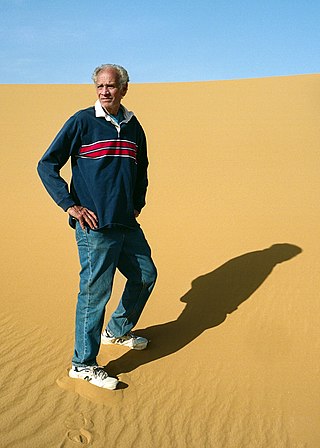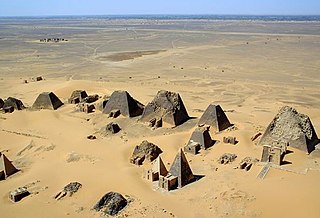Related Research Articles

Egyptology is the scientific study of ancient Egypt. The topics studied include ancient Egyptian history, language, literature, religion, architecture and art from the 5th millennium BC until the end of its native religious practices in the 4th century AD.

Amarna is an extensive Egyptian archaeological site containing the remains of what was the capital city of the late Eighteenth Dynasty. The city was established in 1346 BC, built at the direction of the Pharaoh Akhenaten, and abandoned shortly after his death in 1332 BC. The name that the ancient Egyptians used for the city is transliterated as Akhetaten or Akhetaton, meaning "the horizon of the Aten".

Taharqa, also spelled Taharka or Taharqo, was a pharaoh of the Twenty-fifth Dynasty of Egypt and qore (king) of the Kingdom of Kush, from 690 to 664 BC. He was one of the "Black Pharaohs" who ruled over Egypt for nearly a century.

Sahure was a pharaoh of ancient Egypt and the second ruler of the Fifth Dynasty. He reigned for about 13 years in the early 25th century BC during the Old Kingdom Period. Sahure's reign marks the political and cultural high point of the Fifth Dynasty. He was probably the son of his predecessor Userkaf with Queen Neferhetepes II, and was in turn succeeded by his son Neferirkare Kakai.

Robert Brier is an American Egyptologist specializing in paleopathology. A senior research fellow at Long Island University/LIU Post, he has researched and published on mummies and the mummification process and has appeared in many Discovery Civilization, TLC Network, and National Geographic documentaries, primarily on ancient Egypt.

The Nubian pyramids were built by the rulers of the ancient Kushite kingdoms. The area of the Nile valley known as Nubia, which lies in northern present-day Sudan, was the site of three Kushite kingdoms during antiquity. The capital of the first was at Kerma. The second was centered on Napata. The third kingdom was centered on Meroë. The pyramids are built of granite and sandstone.

Twosret, also spelled Tawosret or Tausret was the last known ruler and the final pharaoh of the Nineteenth Dynasty of Egypt.

The Opet Festival was an annual ancient Egyptian festival celebrated in Thebes (Luxor), especially in the New Kingdom and later periods, during the second month of the season of Akhet, the flooding of the Nile.

Tomb WV24 is an ancient Egyptian tomb located in the western arm of the Valley of the Kings. It was reported by Robert Hay and John Wilkinson in the 1820s and visited by Howard Carter; however, it was not fully explored until Otto Schaden's excavations in 1991.

Nastasen was a king of Kush who ruled the Kingdom of Kush from 335 to 315/310 BCE. According to a stela from Dongola, his mother was named Queen Pelkha and his father may have been King Harsiotef. His successor was Aryamani.

David Bourke O'Connor was an Australian-American Egyptologist who primarily worked in the fields of Ancient Egypt and Nubia.
Henry Reginald Holland Hall MBE, FBA, FSA was an English Egyptologist and historian. In life, he was normally referred to as Harry Reginald Hall.
Donald P. Ryan is an American archaeologist, Egyptologist, writer and a member of the Division of Humanities at Pacific Lutheran University in Tacoma, Washington. His areas of research interest include Egyptian archaeology, Polynesian archaeology, the history of archaeology, the history of exploration, ancient languages and scripts and experimental archaeology. He is best known for his research in Egypt including excavations in the Valley of the Kings where he investigated the long-neglected undecorated tombs in the royal cemetery. His work there resulted in the rediscovery of the lost and controversial tomb KV60, the re-opening of the long-buried KV21 with its two female and likely royal occupants, and tombs KV27, KV28, KV44, KV45 and KV48. In 2017, he rediscovered three small tombs in the Valley of the Kings which when first encountered in 1906 contained the mummies of animals including a dog and monkeys.
Josef William Wegner is an American Egyptologist, archaeologist and Professor in Egyptology at the department of Near Eastern Languages and Civilizations of the University of Pennsylvania, where he obtained his Ph.D. degree in Egyptology in 1996. He specializes in Egyptian Middle Kingdom archaeology. His father is the astrophysicist, Gary A. Wegner.
Richard H. Wilkinson is an archaeologist in the field of Egyptology. He is Regents Professor Emeritus, Ph.D. at the University of Arizona and founding director of the University of Arizona Egyptian Expedition. He conducted research and excavation in Egypt for 25 years, mainly in the Valley of the Kings, and most recently excavating the royal temple of Twosret, a queen of the Nineteenth Dynasty of Egypt who ruled Egypt as a king.

Senkamanisken was a Kushite King who ruled from 640 to 620 BC at Napata. He used royal titles based on those of the ancient Egyptian pharaohs.

Nuri is a place in modern Sudan on the west side of the Nile, near the Fourth Cataract. Nuri is situated about 15 km north of Sanam, and 10 km from Jebel Barkal.

The Kingdom of Kush, also known as the Kushite Empire, or simply Kush, was an ancient kingdom in Nubia, centered along the Nile Valley in what is now northern Sudan and southern Egypt.

Toby Alexander Howard Wilkinson, is an English Egyptologist and academic. After studying Egyptology at the University of Cambridge, he was Lady Wallis Budge Research Fellow in Egyptology at Christ's College, Cambridge and then a research fellow at the University of Durham. He became a Fellow of Clare College, Cambridge in 2003. He was Deputy Vice Chancellor at the University of Lincoln from 2017 to 2021, and then Vice Chancellor of Fiji National University from January 2021 to December 2021. Since 2022, he has been Fellow for Development at Clare College, Cambridge.

The Twenty-fifth Dynasty of Egypt, also known as the Nubian Dynasty, the Kushite Empire, the Black Pharaohs, or the Napatans, after their capital Napata, was the last dynasty of the Third Intermediate Period of Egypt that occurred after the Nubian invasion.
References
- ↑ Fieldwork/Egyptian Expedition.
- ↑ Ikram, S. "Nile Currents," Kmt 23.4 (2012): 6.
- ↑ Creasman, P. P. "The Cairo Dashur Boats," INA Quarterly 32.1 (2005): 15-19.
- ↑ https://journals.uair.arizona.edu/index.php/jaei/about/editorialTeam Editorial Team/Journal of Ancient Egyptian Interconnections.
- ↑ National Geographic Society, Waitt Grants complete list .
- ↑ NSF Award Search: Award Abstract #1203445 - CSBR: Natural History Collections: Urgent Improvements to Housing and Accessibility of the World's Largest, Most Diverse & Significant Dendrochronological Collection .
- ↑ "UA Awarded Two Save America's Treasures Grants," .
- ↑ "Pearce Paul Creasman '03: A renowned scholar explores ancient maritime life among the temples and tombs of Egypt". University of Maine Alumni Association.
- ↑ ProQuest Citation: Creasman, P. P. (2010). Extracting cultural information from ship timber. (Order No. 3446659, Texas A&M University). ProQuest Dissertations and Theses, 227. Abstract: .
- ↑ Spencer, P. "Digging Diary 2012," Egyptian Archaeology 42 (2013): 26.
- ↑ Creasman, P. P. "Tausret Temple Project: Report for the 2011 Season," The Ostracon 23 (2012): 3-7 http://egypt.arizona.edu/sites/default/files/Tausert_11_Season.pdf .
- ↑ Peeples, L. "Rings and Worms Tell the Tale of a Shipwreck Found at Ground Zero," Scientific American, 10 June 2011